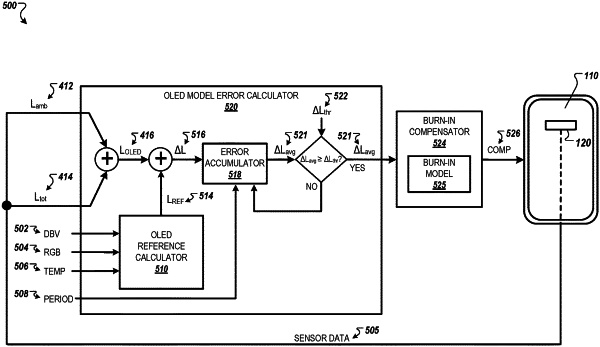| CPC G09G 3/3233 (2013.01) [G09G 2320/0295 (2013.01); G09G 2320/045 (2013.01); G09G 2320/046 (2013.01); G09G 2330/10 (2013.01); G09G 2360/147 (2013.01); G09G 2360/16 (2013.01)] | 15 Claims |

|
1. A method for driving a display, a sensor being arranged behind the display to receive light transmitted by light-emitting pixels of the display; the method comprising:
driving the display with driving voltage signals that are compensated according to a burn-in model that represents predicted pixel degradation over time;
determining a luminance of light received by the sensor during an emission-on period during which a subset of the light-emitting pixels in front of the sensor emit light, wherein during the emission-on period, the subset of the light emitting pixels in front of the sensor emit light according to programmed display brightness values;
determining a luminance of light received by the sensor during an emission-off period during which the subset of the light-emitting pixels in front of the sensor emit no light;
calculating, by comparing the luminance of the light received by the sensor during the emission-on period to the luminance of the light received by the sensor during the emission-off period, a luminance of light internally reflected from the subset of the light-emitting pixels and received by the sensor during the emission-on period;
calculating, using the programmed display brightness values, a reference luminance comprising an expected luminance of light internally reflected from the subset of the light-emitting pixels and received by the sensor when the subset of the light-emitting pixels emit light according to the programmed display brightness values;
determining that a difference between the luminance of light internally reflected from the subset of the light-emitting pixels and the reference luminance equals or exceeds a threshold difference;
in response to determining that the difference between the luminance of light internally reflected from the subset of the light-emitting pixels and the reference luminance equals or exceeds a threshold difference, adjusting the burn-in model by a correction factor to obtain an adjusted burn-in model; and
driving the display with adjusted driving voltage signals that are compensated according to the adjusted burn-in model.
|